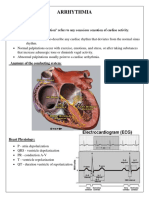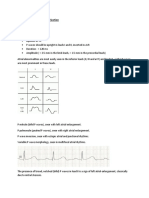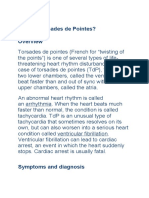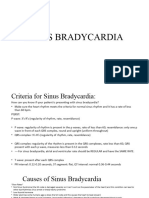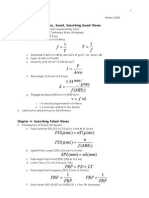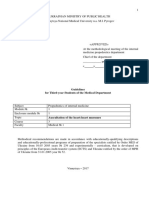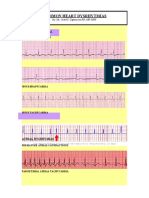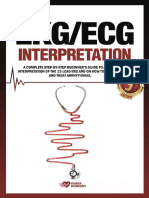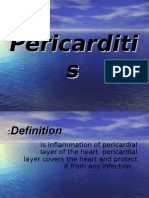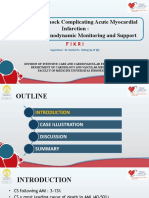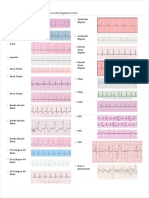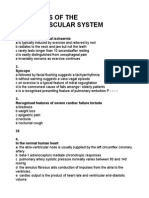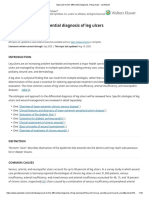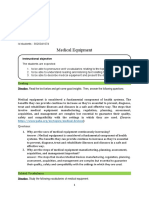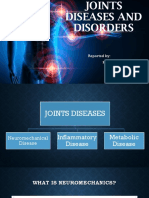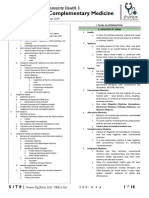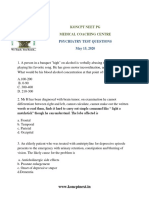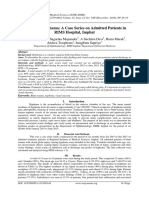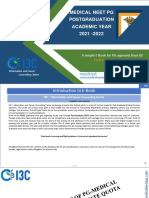Cardiac Pacing: Terms You Will Become Familiar With in This Section of The
Uploaded by
Clt MiskeenCardiac Pacing: Terms You Will Become Familiar With in This Section of The
Uploaded by
Clt MiskeenHUMANS AND MACHINES : Medical Te chnology a t work PRESENTATION DRAFT COPY
CARDIAC PACING
Terms you will become familiar with in this sec tion of the module cardiology pulmonary circulation PQRST waves electrocardiography sinus node sinoatrial node pulse oximeter transthoracic pacing intra-aortic balloon pump cardiotomy image intensifier 5F bipolar wire roller pump cross clamp myocardial infarction GTN infusion arrhythmia ischaemia stenosis refractory response systole augmentation augmentation hypertensive anticoagulant antegrade hypothermia mammary retractor distal arteriotomy INTRODUCTION Ideas about how the heart functions [haemodynamics] and its relation to blood pressure are not new. They are pictured on the walls of Egyptian pyramids and in early wood etchings. The search for understanding of how the heart works and how the flow of blood is governed by it are equally important to diagnosis, monitoring and the developing therapies and procedures established in cardiology. cardio vascular system systemic circulation ECG paper cardiac pacing atrioventricular node end tidal CO2 monitor datascope transvenous endocardial pacing sternal retractor angiogram infusion pump cannula centrifugal pump dissection interventricular septum serial/continuous ECG bolus dose isoelectric line afterload counter-pulsation diastole occlusion morphology activated clotting time cardioplegia retrograde saphenous vein sternal retractor anastomosis weaning
DRAFT COPY MARCH 1998
AUSTIN NURSING EDUCATION AND RESEARCH CENTRE
HUMANS AND MACHINES : Medical Te chnology a t work PRESENTATION DRAFT COPY
Many devices are now used in medicine and nursing to measure, assess or monitor the way the heart [cardiac] and blood vessels [vascular] of the cardio-vascular system are performing. Increasingly, their principles can also be used in repairing and restoring healthy function to diseased hearts. Some of these technologies use metal electrodes stuck to the surface of the skin to monitor the heart rate and rhythm. Others use electrodes to restore heart rate or rhythm. In some, tubes [catheters] must be placed directly into the blood vessels to measure cardiac function [invasive monitoring]. In others, catheters are used to bypass the heart while it is repaired These processes can create significant risks for the client. Clients requiring invasive procedures often need a simple explanation of what is being done to them to reduce their fears and to gain their support in maintaining accurate monitoring or ensuring safe recovery. Family and friends may also need simple details to reduce their stress levels. Anatomy and Physiology The heart is basically a muscular pump. Its function is to pump blood through the lungs ( [pulmonary circulation ] where it will pick up oxygen and excrete carbon dioxide. It then pumps this blood around the body [systemic circulation ] where it will deliver oxygen and pick up carbon dioxide. The reason the healthy heart keeps pumping day in and day out is because of its ability to self stimulate, to contract (therefore pump) and relax (therefore fill up again) with amazing regularity. To create the contractions, the heart has its own electrical generator and conducting system. The Elec trocardiograph is a recording of the electrical activity of the heart's generator and a tracking of elec trical impulses along the conduction system in the heart. The electrical impulse stimulates an orderly contraction of the heart muscle forcing blood out of the heart and around the body. When the impulse ends, the heart muscle relaxes. The various elements of electrical activity of the heart are shown in graphical form as the PQRST waves on ECG paper or on screen. This non-invasive procedure is detailed in the section titled Cardiac monitoring. It is expected that you will complete these two sections together as they rely on the same anatomy and physiology. Cardiac pacing Cardiac Pacing is the repetitive delivery of very low electrical energies to the heart to initiate and maintain cardiac rhythm. Loss of cardiac rhythm results in poor transport of oxygen to cells in the tissues which lose their capacity to produce energy and then begin to die.
DRAFT COPY MARCH 1998
AUSTIN NURSING EDUCATION AND RESEARCH CENTRE
HUMANS AND MACHINES : Medical Te chnology a t work PRESENTATION DRAFT COPY
In the normal heart, pacemaker cells have the specialist property of starting and maintaining a rhythmic heart beat by generating very small electrical impulses to stimulate the heart in a regular pattern.
DRAFT COPY MARCH 1998
AUSTIN NURSING EDUCATION AND RESEARCH CENTRE
HUMANS AND MACHINES : Medical Te chnology a t work PRESENTATION DRAFT COPY
ACTIVITY Use a standard reference text to locate all areas of the heart which could sustain a rhythmic heart beat. Use your research to relate the areas of the heart shown in the diagram below with the list on the right side of the page.
sinus node atriventricular [AV] node LBB [posterior fascicle] LBB [anterior fascicle] Bundle of His RBB
Conductive system of the heart On the line connecting the named areas with their location on the diagram, indicate the inherent discharge rate of each one. The sinoatrial node is usually the dominant pacemaker, overriding all other subsidiary pacemakers. The lower pacemakers are essentially emergency standby pacemakers, in case the sinoatrial node or some part of the conduction system, such as the atrioventricular node, happens to fail. The diseased heart may lose its ability to generate its own electrical impulses or to generate them evenly and constantly. If this begins to happen, it may be necessary to provide the heart with an artificial pacemaker. The pacing may be temporary or permanent.
DRAFT COPY MARCH 1998
AUSTIN NURSING EDUCATION AND RESEARCH CENTRE
HUMANS AND MACHINES : Medical Te chnology a t work PRESENTATION DRAFT COPY
CASE STUDY Equipment which is emphasised, referred to or used in this case study includes: Monitoring ECG - continuous, serial, 12 lead ECG End Tidal CO 2 monitor Blood pressure monitor Pulse oximeter Chest X-Ray Datascope ac tivated clot ting time body temperature blood gases Haemostatic transthoracic cardiac pacing transvenous endocardial pacing circuit Intra-aortic balloon pump saw punch mammary retrac tor sternal retrac tor cardiotomy suction lines vent lines catheter drains Diagnostic angiogram Image intensifier Therapeutic infusion pumps - GTN, heparin 5 F bipolar wire cannula roller pumps Centrifugal pumps cross clamp cardiotomy suction lines vent lines Mr. Kennett, a 52 year old entrepreneur was admitted to the coronary care unit after he complained of crushing chest pains while he was engaged in unaccustomed physical exertion.
DRAFT COPY MARCH 1998
AUSTIN NURSING EDUCATION AND RESEARCH CENTRE
HUMANS AND MACHINES : Medical Te chnology a t work PRESENTATION DRAFT COPY
Driving himself to the accident and emergency department of his nearest Medical Centre, he did not clearly state why he had come because the attack seemed to have passed and he felt a bit silly being there. As a result, he said that he had a stomach upset so he was not accepted as needing emergency treatment. As a result of a routine ECG to rule out cardiac problems, it was revealed that he had had a heart attack. Necessary medication to limit heart damage had not been administered in the designated time frame. When he did receive streptokinase to dissolve any blood clots [thrombolytic therapy], the benefits were minimal for him. As a result of the ineffective and late response, Mr Kennett suffered a serious heart attack [myocardial infarction] (confirmed by cardiac enzymes taken in the A&E department) and was admitted to the coronary care unit. The injured areas of the heart were the wall which divides the left and right ventricles - the lower chambers - of the heart [interventricular septum] which supports the conduction system of the heart and a section of the front [anterior wall] of the left ventricle. A high risk of abnormal rhythm disturbance was created and the development of life-threatening rhythms became a real risk. In the coronary care unit, blood was taken for analysis to determine the amount of damage and to check that biochemistry parameters were within normal limits. Mr Kennett was placed on continuous ECG monitoring, a GTN infusion and a Heparin infusion were commenced according to thrombolytic therapy unit protocol, a Chest X-ray [CXR] was taken and serial ECGs and serial Cardiac Enzyme monitoring begun. Ac tivity Make a list of the equipment needed within the coronary care unit to provide for Mr Kennett's immediate monitoring and maintenance needs. Identify the invasive and the non-invasive monitoring, maintenance and diagnostic procedures he is undergoing at this point in his treatment. Mr Kennett's physical condition remained relatively stable for the first day. On the second day he began to develop irregular heart beats [arrhythmias] with increased frequency. The nursing staff diagnosed a 2nd degree type two A V block, with a ventricular response of 40 beats per minute and a mean blood pressure of 65. This quickly deteriorated to complete heart block [3rd degree heart block]. Questions Use your reference sources to find out about the second degree type two AV block. What other types of blocks are there? Is this a very serious event?
DRAFT COPY MARCH 1998 AUSTIN NURSING EDUCATION AND RESEARCH CENTRE 6
HUMANS AND MACHINES : Medical Te chnology a t work PRESENTATION DRAFT COPY
If Mr Kennett was a healthy man, what could you expect his normal heart rate and mean blood pressure readings to be? What would you expect to happen to ventricular response rate and blood pressure at the point of complete block? What risks exist if the situation is not remedied quickly? How fast is 'quickly' in this case? A bolus dose of 0.20mg of Isuprel was given increase heart rate, cardiac output and blood pressure and Mr. Kennett responded well. It was decided not to commence an isuprel infusion which may have increased the demand for oxygen and, subsequently, the infarct size. It was decided he would be managed with transthoracic cardiac pacing until temporary transvenous endocardial pacing was set up. transthoracic cardiac pacing Ac tivity Locate the transthoracic pacing equipment in the Coronary Care, Intensive Care or Accident and Emergency units of your Medical Centre and familiarise yourself with the routine maintenance requirements of the unit. Does your centre have a routine checking and maintenance procedure published for the equipment? Is it adequate to the importance of the equipment? Are there any particular features which require more careful checking than a routine inspection might demand? Questions Is there a special checking procedure for battery powered transthoracic pacing equipment? Why might the routine checks and maintenance for battery operated equipment be different from those for mains powered equipment? Some electronic pacing equipment has a built-in defibrillation unit. What effect might the use of this unit have on the effective life of batteries in the equipment? Working with the medical or nursing staff or by reference to texts, find answers to the following questions: What is a 'bolus dose'? How could isoprel [or isoprenaline or isoproterenol] increase the heart's demand for oxygen? How might this increased oxygen demand generate a further infarct? What are the indications for pacing? Which parts of the PQRST graph are going to reflect the nature of Mr Kennett's infarct history? Artificial pacing or generation of electrical impulses to maintain a normal heart rhythm is usually instituted when for some reason the normal pacemaker of the heart fails and the other pacemakers that may take over
DRAFT COPY MARCH 1998 AUSTIN NURSING EDUCATION AND RESEARCH CENTRE 7
HUMANS AND MACHINES : Medical Te chnology a t work PRESENTATION DRAFT COPY
might not respond at a sufficiently rapid rate or produce effective contractions to sustain adequate blood supply [cardiac output] to the rest of the body. Damage to that part of the heart which supports the conduction system was the reason Mr. Kennett developed the more serious rhythm disturbance because this has interrupted electrical impulses travelling to the lower, ventricular, part of the heart. Transthoracic pacing was successfully instituted for the client but after 10 minutes of pacing, the pacemaker began to lose one-to-one capture so the electrical stimulus was not followed by a QRS complex each time. Because the patient was totally dependant on the pacemaker for survival, the problem demanded immediate attention. The unreliability of the transthoracic pacemaker was dangerous. Its total malfunction might result in the client's death. The nursing staff checked the output and tried to increase it. This caused a great deal of pain and patient intolerance despite his being given 10 mg of intravenous [IV] diazepam. The wiring and other components were checked and as nothing unusual could be detected, it was decided that there must be a malfunction. You are called to sort out the problem. You ask the preliminary questions which show the nursing staff have already checked the points detailed above. As you hurry to the coronary care unit, you consider the possibilities but you have checked the equipment recently. It should be working? Questions If the nursing staff have made the checks described above and the equipment is functioning normally, what could be causing this loss of capture? With transthoracic pacing there are two large electrodes placed on the anterior (front) and posterior (back) chest wall. To ensure capture there must be good skin contact. Failure to capture may be associated with changes in patient position which may loosen the pacing electrode or its connections, or cause the posterior electrode to buckle. Taping the electrode to the patient's chest wall may help to prevent poor contact. Subtle changes in the patient's condition may require an increase in the current to maintain capture. The threshold may change during electrolyte imbalance, when there is a diminished blood supply, anaemia, congestive heart failure, hypoxia and/or with new drug therapy.
DRAFT COPY MARCH 1998
AUSTIN NURSING EDUCATION AND RESEARCH CENTRE
HUMANS AND MACHINES : Medical Te chnology a t work PRESENTATION DRAFT COPY
The problem is corrected before you arrive and the pacing resumes without complications. Meanwhile, the procedure room has been prepared for insertion of the transvenous pacing wire to be connected to an external pulse generator. transvenous endocardial pacing circuit Mr. Kennett signed the consent papers and was prepared for the insertion of the temporary wire ( a 5 F bipolar wire) using the transvenous approach via the right groin under fluoroscopy. The procedure was well tolerated by the patient. He was paced at 70 beats per minute, VVI mode. After the wire was checked for proper placement using the image intensifier, sutured and dressed, he was returned to CCU. In CCU, nursing staff monitored the ECG, pacemaker settings were noted and verified and connections were secured and the pacing threshold was checked. A 12 lead ECG [see next section] was taken to confirm function of the pacemaker. Everything seems to be going well when suddenly the second pacemaker began to lose capture. Mr Kennett was turned onto his left side in an attempt to bring the electrode in contact with the apex of the right ventricle - but nothing happened. The nursing staff checked the output on the pulse generator and turned it up, nothing happened. They checked the wire and secured all connections - nothing happened. They changed the pulse generator over for a new one - nothing happened. They checked and changed the battery - still nothing happened. There were no other pulse generators to use. Mr. Kennett was now symptomatic [his blood pressure was falling due to his decreased heart rate] and the nurses were worried. Again you were called in to fix the problem Questions Again, the nursing staff have done all the right things to try to re-establish capture.
Maybe some people are born unlucky!
What are some common electrical and mechanical reasons for the loss of contact? What could be the problem? If the problem is not a result of equipment malfunction, medical or nursing care, then it is most likely to be related to the infarct itself. [When everything is impossible, check the impossible - just to be sure]
DRAFT COPY MARCH 1998
AUSTIN NURSING EDUCATION AND RESEARCH CENTRE
HUMANS AND MACHINES : Medical Te chnology a t work PRESENTATION DRAFT COPY
Infarcted tissue does not respond to electrical stimulation. The tissue surrounding it is likely to suffer poor oxygenation [ischaemic] and the delays and interruptions in treatment have amplified this problem. It is likely that the tip of the catheter is up against infarcted (dead) or ischaemic (poorly oxygenated ) tissue which means that even though electricity is delivered to the heart it cannot be conducted because of the state of the tissue. What needs to happen is for the wire to be remanipulated ASAP so that the tip of the wire is in contact with normal heart muscle tissue. The wire is re-manipulated and capture is re-established, but all is still not well. Mr. Kennett begins to complain of tightness in the chest. Later in the day Mr. Kennett begins to develop more chest pain and it seems that the infarct is extending. In order to reverse this progression, the doctor has ordered nitroglycerine [GTN] to open up the blocked arteries, low dose dopamine to increase blood supply to his kidneys to increase urine output, furosemide to increase his urine output which will decrease the work that the failing left ventricle will have to do and morphine to control the pain. Despite this, the client continues to have chest pain and his ECG shows that he has signs of new or fresh damage (infarction) to his heart [a rise of the ST segment 2 mm above the isoelec tric line in the left lateral leads [V5, V6, 1 & AVL]. Mr. Kennett's condition worsens. Medication is not resolving the situation and it appears that he will need a coronary angiogram as soon as possible. The angiogram is organised and reveals triple vessel disease with a 90 per cent stenosis of the left main coronary artery requiring grafts. The surgery cannot be arranged immediately as there are other urgent cases and Mr. Kennett does not have private health insurance so he must wait his turn. It is decided that an intra-aortic balloon pump [IABP] will be inserted to buy him some time while he waits for surgery.
DRAFT COPY MARCH 1998
AUSTIN NURSING EDUCATION AND RESEARCH CENTRE
10
HUMANS AND MACHINES : Medical Te chnology a t work PRESENTATION DRAFT COPY
Cycle of events in Cardiogenic shock CARDIAC SURGERY Myocardial Infarc tion loss of viable ventricular contrac tile myocardium Increased Myocardial Ischaemia Decreased left ventricular function decreased oxygen supply decreased coronary perfusion Decreased blood pressure increased oxygen demand increased heart rate increased afterload - svr Increased Myocardial Ischaemia cardiac trauma
Decreased cardiac output [after-load is resistance against which the left ventricle must pump] Medical intervention is aimed at correcting the cause of the imbalance between supply and demand. When the cardiac failure is resistant to medical intervention [refrac tory], balloon counter-pulsation may be the next step in treatment. [Source: Dowd, 1996]
DRAFT COPY MARCH 1998
AUSTIN NURSING EDUCATION AND RESEARCH CENTRE
11
HUMANS AND MACHINES : Medical Te chnology a t work PRESENTATION DRAFT COPY
Intra-aortic balloon pump The IABP is a short term solution. It will not cure the problem but it will help to reverse left ventricular failure (the left ventricle not pumping adequately to sustain long term life). This will give the client a chance to recover enough to increase his survival chances when he undergoes his coronary artery bypass grafts. The IABP can help Mr. Kennett in two ways: It will reduce the work of the left ventricle. It will help to force more oxygenated blood into the coronary arteries which feed blood to the heart. This will help to reduce any further damage from being done to the heart. The IABP is an ingenious left ventricular assistance device. The device includes a small balloon [which is inserted in the descending thoracic aorta] and an external pump console. Using helium, the console inflates and deflates the balloon in time with the patient's cardiac cycle [Weinberg, 1988]. The IABP works by inflating and deflating the balloon in the descending aorta using helium [the favoured gas because it is inert and very light it travels rapidly] which is shuttled between the patient balloon and the console balloon. [NOTE: this applies for the older Datascope, newer models use a piston drive so wear and tear on the console balloon is eliminated] In the aorta, co-ordinated with the cardiac cycle, blood is shifted or displaced back up to the coronary arteries and upper limbs and brain (inflation) thus increasing the amount of oxygenated blood flow to these areas. Blood is also shifted downwards (inflation) towards the lower parts of the body thus increasing blood flow to the kidneys, bowel and lower limbs.
DRAFT COPY MARCH 1998
AUSTIN NURSING EDUCATION AND RESEARCH CENTRE
12
HUMANS AND MACHINES : Medical Te chnology a t work PRESENTATION DRAFT COPY
[Source: Dowd, 1996] fig 1 Basic sections of ECG graph When the balloon deflates, the pressure in the aorta drops to a significantly lower level than it normally would [see fig 2]. This allows the heart to overcome the pressure in the aorta and open the aortic valve much more easily. As a result, the heart doesn't have to work as hard [approximately 80 per cent of the oxygen available to the heart is used to overcome the pressure in the aorta and open the aortic valve]. When the heart doesn't have to work as hard, it uses less oxygen and needs less oxygen. Since the heart cannot get its normal supply because of the blockages, the IABP helps to restore a balance even if only for a short time. ACTIVITY Locate an intra-aortic balloon pump in your Medical Centre and explore Mr. Kennett is still down to the catheter lab and will have his balloon catheter inserted under fluoroscopy, again using the image intensifier. The radiographer arrives to operate the portable image intensifier. Everyone is ready to begin, the patient's condition is very serious and there is a sense of urgency that the procedure needs to be completed as soon as possible. The cardiologist has already started to insert the balloon catheter. The position of the catheter is constantly checked because if its put too high then it could end up blocking the left subclavian artery which supplies the left arm or even damage the artery by putting a tear [dissec tion ] in it. If the catheter is placed too low, then the risk of blocking off [occluding] the renal arteries increases. This will result in a decrease in renal blood flow which will lead to renal failure.
DRAFT COPY MARCH 1998 AUSTIN NURSING EDUCATION AND RESEARCH CENTRE 13
HUMANS AND MACHINES : Medical Te chnology a t work PRESENTATION DRAFT COPY
The radiographer attempts to screen the catheter but nothing happens! She tries again and again. The cardiologist is getting impatient, Mr. Kennett's condition is worsening and the fluoroscopy machine won't work. Help!! You are called urgently to solve the problem. Ac tivity Find a portable image intensifier and explore the possible causes for image loss. Discuss the problem with your radiographer and compare your findings with the information they provide. Is the problem developed in this case study a common one? How could its occurrence be minimised? Is there a routine check which would eliminate the possibility of the problem? Can the problem be fixed in the sterile atmosphere of the theatre? The balloon catheter is finally inserted and there is confirmation that it is in the correct place. The patient is returned to the coronary care unit with the IABP in progress and everything seems to be working well when suddenly the nurses become concerned because the patient's status is again beginning to deteriorate. He is suffering chest pain again and the balloon driven pressure [diastolic augmentation] is dropping. The balloon pressure waveform does not look right [see fig 3], and the alarms for 'loss of diastolic augmentation' and 'Helium loss' keep going off.
fi g 2 Arterial waveforms during IABP therapy [Source: Datascope - Case studies in Intra-aortic balloon pumping]
DRAFT COPY MARCH 1998
AUSTIN NURSING EDUCATION AND RESEARCH CENTRE
14
HUMANS AND MACHINES : Medical Te chnology a t work PRESENTATION DRAFT COPY
The staff are not very familiar with the IABP and they are extremely anxious about the serious situation. After briefly trying to sort out the problem, they call you. Questions What is the balloon pressure waveform? What could be the problem? During the cycle of inflation and deflation, helium is rapidly moved in and out of the balloon. The environment within the balloon and surrounding forces that affect the balloon behaviour all contribute to a predictable pattern of gas flow and pressure.
fig 3. Normal balloon pressure waveform The gas pressure characteristics are converted into a waveform that is reflective of the behaviour of the gas. This transduced waveform can tell a lot about the interaction of the balloon within the patient's aorta. A thorough understanding of the balloon pressure waveform is also important for effective trouble shooting of the console as most of the alarm states are based on this gas surveillance system. In this case, there are two factors which commonly cause a problem by affecting the waveform: normal variations - due to variations in heart rate, irregular diastolic phase, variations due to aortic pressure [see fig above.
DRAFT COPY MARCH 1998
AUSTIN NURSING EDUCATION AND RESEARCH CENTRE
15
HUMANS AND MACHINES : Medical Te chnology a t work PRESENTATION DRAFT COPY
abnormal morphology - due to gas loss and high pressures [see fig 4 below]
[Source: Dowd, 1996: 11-5] fig 4 abnormal IABP wave forms These may be generated by: leaks in the balloon membrane; kinks in the catheter system; balloon too big for the aorta; balloon not fully unwrapped; patient hypertensive (high blood pressure); incorrectly placed balloon; balloon has not exited the sheath [Dowd, 1996]. Mr. Kennett has been on the IABP for two days when finally he is scheduled for his coronary artery bypass grafts. During this time his temperature rises and a consequent Helium loss triggers the alarm system. Fortunately the nursing staff have seen this happen before and they administer medication to reduce Mr Kennett's temperature. Haemodynamic monitoring Cardiac surgery is an extremely invasive procedure which is prolonged and a challenge to manage. As a result, the level and complexity of monitoring is substantial and the demand for reliability and precision is acute. The types of haemodynamic monitoring that are likely to be employed during the operation for Mr. Kennett are arterial blood pressure monitoring, pulmonary pressure monitoring, and cardiac output monitoring. These are in addition to the types of monitoring that are employed in nearly all other operations [eg pulse oximetry, ECG, end tidal, CO2 monitoring]. Other types of monitoring required will include: activated clotting time, body temperature, and blood gases.
DRAFT COPY MARCH 1998
AUSTIN NURSING EDUCATION AND RESEARCH CENTRE
16
HUMANS AND MACHINES : Medical Te chnology a t work PRESENTATION DRAFT COPY
Cardiopulmonary Bypass During cardiac surgery it is usually necessary to immobilise the heart in order to provide a still and blood free operative target. Oxygenation of the patient and perfusion of the body must be maintained and this is achieved with the technique of cardiopulmonary bypass. During cardiopulmonary bypass, venous blood is siphoned from the patient into the bypass machine where it is oxygenated and the temperature is controlled . This blood is then pumped back into the patient under sufficient pressure to perfuse body tissue. Ac tivity Use your resource books to identify the following structures:- aorta, vena cava, pulmonary artery, pulmonary vein, 4 chambers and 4 valves of the heart, coronary arteries.
Explain how the valves prevent back flow of blood. In order to siphon blood from the patient and return it, cannulae must be inserted into strategic points [one cannula, more than one - cannulae] and these are connected to tubing which carries the blood to the bypass machine. To maintain appropriate blood pressures and flow rates, the diameters of the cannulae must approximate the diameters of the veins and arteries they are extracting from and pumping into.
DRAFT COPY MARCH 1998
AUSTIN NURSING EDUCATION AND RESEARCH CENTRE
17
HUMANS AND MACHINES : Medical Te chnology a t work PRESENTATION DRAFT COPY
Ac tivity Identify the possible sites for placement of the arterial cannula (carries blood from the pump back to the patient). Identify the possible sites for placement of the venous cannula (carries blood from the patient to the pump). Outline the flow of blood from the body through the pump and back to the body. When blood is exposed to foreign surfaces or air as it leaves the body, it tends to clot. To reduce this tendency, it is necessary to give an anticoagulant [Heparin] before a patient is put onto bypass. To assess the degree of anticoagulation which has occurred, the ac tivated clotting time [ACT] is measured before running on to bypass and then at regular intervals during the bypass period. The roller pumps on the bypass machine tend to cause damage to blood cells so the bypass time is kept to a minimum and the surgical team try to be as efficient as possible during this time. Centrifugal pumps are less destructive to blood cells. Ac tivity Use your resource texts to compare the structure and function of roller pumps and centrifugal pumps. Establish how the roller pumps damage blood cells and consider how this problem is reduced in the centrifugal pump. Suggest why roller pumps may have been considered more acceptable than other pump types during the earlier development of bypass surgical techniques. In addition to the arterial line and the venous line there are two more smaller lines which take blood from the patient back to the pump and these are the cardiotomy suction, and vent lines. The cardiotomy line collects any blood which is outside the heart and vessels during the operation and the vent is used to ensure that the left ventricle is never over-distended because the left ventricle can be damaged if it is stretched too much. Cardioplegia Cardioplegia is administered to stop the heart from beating [cardiac arrest] so that the operative target is still while it is being operated on. It is a high concentration potassium solution which, when delivered directly to the heart muscle, stops [causes cessation of] electrical activity in the heart and the heart muscle becomes still. Cardioplegia can be delivered antegradely and retrogradely. Ac tivity
DRAFT COPY MARCH 1998
AUSTIN NURSING EDUCATION AND RESEARCH CENTRE
18
HUMANS AND MACHINES : Medical Te chnology a t work PRESENTATION DRAFT COPY
Use your reference books to research cardioplegia and then refine your understanding of the procedure in discussion with experienced surgeons and nursing staff using the following questions as a basis for your research: How is antegrade cardioplegia delivered to the coronary arteries? Why does a cross clamp have to be applied to the aorta before the administration of the antegrade cardioplegia? How is retrograde cardioplegia delivered 'backwards' to the coronary arteries? Questions In the past, patients were cooled during cardiac surgery. What is the effect of hypothermia on metabolism and oxygen demand of the tissues? Why might this cooling procedure by seen as an added complication by surgeons? Now there is a trend away from cooling although this has not been universally been embraced. Equipment is very reliable these days making oxygenation very effective on bypass and some surgeons do not believe that cooling is necessary Coronary artery bypass graf ts On the basis of Mr Kennetts heart injury, his surgery has been planned to bypass obstructions in the left anterior descending, the circumflex, and the posterior descending arteries. A diagram made from the preoperative coronary angiogram is in the operating room for the surgeon to refer to. It has been decided to use both left and right internal mammary arteries and one length of saphenous vein from the left leg as the bypass conduit [grafts]. Ac tivity Using an anatomy reference text, locate the: left anterior descending, the circumflex, and the posterior descending arteries; the mammary arteries; and the saphenous veins. These vessels will have to be mobilised so that they can be used for the coronary artery bypass grafts (CABG)
DRAFT COPY MARCH 1998
AUSTIN NURSING EDUCATION AND RESEARCH CENTRE
19
HUMANS AND MACHINES : Medical Te chnology a t work PRESENTATION DRAFT COPY
The fundamental steps of the CABG operation are as follows:
Mr Kennett is positioned on the operating table in a supine position. A cathet er is inserted into his bladder so that hourly measurements of urine can be made to monitor his renal function. The front of his body is painted with an antiseptic solution and sterile drapes are applied to create a sterile field.( Infection risk is increased by the length and extent of the surgery) A midline incision is made and a saw is used to split the sternum or breast bone. A mammary retrac t or is used to retract one side of the sternum at a time and the mammary arteries are mobilised. Simultaneously another surgeon harvests saphenous vein from the leg. The mammary retractor is removed and the sternum is spread apart with a sternal retrac t or. The bypass cannulae are inserted and cardiopulmonary bypass is initiated. Cooling may be actively done to reduce the patient's metabolic rate. This is achieved as the patient's blood is processed by the pump. A cross clamp is applied to the aorta and cardioplegia is delivered to the coronary arteries to effect cardiac arrest. Obstructed coronary arteries are identified and an art eriotomy is made distally to the stenoses with a fine blade.. Graft material (vein or artery) is anastomosed to the coronary artery, and this is called a distal anastomosis. An arteriotomy is made in the aorta and this is then shaped with a round punch. The other or spare end of the graft material which is anastomosed to the coronary artery is then anastomosed to the aorta. This is called a proximal anastomosis. All distal anastomoses may be done initially and then proximals next or a combination of distals and proximals may be the order of events chosen. Cardioplegia is given at regular intervals until the anastomoses are completed [usually every 20 minutes]. The patient is rewarmed (if necessary) and the aorta deaired with a cannulated needle. When the heart is beating satisfactorily, the patient is weaned from bypass and the cannula are removed. Chest drains are inserted, and when haemostasis is satisfactory, the wound is closed. Mr Kennett is transferred to the intensive care unit (ICU).
Mr Kennett recovered from his great adventure through the hospital system and sent a letter of thanks to the medical and nursing staff who cared for him during his illness. He will never be aware of the importance of the support he received from the silent members of his health care team. The biomedical engineers and technicians maintained the equipment and supported the medical and nursing staff because they understood the importance of their role, the complexity of the relationship between technology and their client and the need to know what could be repaired, what was not a technical problem and when technical expertise and rapid action were a matter of life or death. References Appel-Hardin, S. and Dente-Cassidy, A.M. How to use a non-invasive temporary pacemaker, Nursing. May, 59-64
DRAFT COPY MARCH 1998 AUSTIN NURSING EDUCATION AND RESEARCH CENTRE 20
HUMANS AND MACHINES : Medical Te chnology a t work PRESENTATION DRAFT COPY
Barbiere, C.C. (1993) From emergent transvenous pacemaker to permanent implant and follow-up, Critical Care Nurse. April 39-44 Datascope Corporation (undated) Intra-aortic Balloon Pumping. New Jersey: Datascope Corp. Datascope Corporation (1988) Balloon Pump Therapy: When Your Heart Needs Help. New Jersey: Datascope Corp. Dowd, B. (1996) ARROW In-service program. Richmond, Victoria:Anaesthetic Supplies Pty Ltd. Weinberg, L.A. (1988) Buying time with an intra-aortic balloon pump, Nursing. September, 44-49
DRAFT COPY MARCH 1998
AUSTIN NURSING EDUCATION AND RESEARCH CENTRE
21
You might also like
- Acid-Base Balance + Arterial Blood GasesNo ratings yetAcid-Base Balance + Arterial Blood Gases30 pages
- Electrophysiology Study and Cardiac AblationNo ratings yetElectrophysiology Study and Cardiac Ablation29 pages
- SH - Structural, Infectious, Inflammatory Cardiac Disorders and Severe Complications of Heart Disease2014No ratings yetSH - Structural, Infectious, Inflammatory Cardiac Disorders and Severe Complications of Heart Disease2014150 pages
- Q: Characterize The Different Types of Pacemaker. Explain The Various Steps of Pacing100% (1)Q: Characterize The Different Types of Pacemaker. Explain The Various Steps of Pacing4 pages
- Cardiac Arrhythmia Lecture Final-2025-1No ratings yetCardiac Arrhythmia Lecture Final-2025-130 pages
- Introduction To Interpretation V10.0 (2017-2018)No ratings yetIntroduction To Interpretation V10.0 (2017-2018)91 pages
- Cardiovascular Pathology - 026) Acyanotic Congenital Heart Defects CHD Part 1 (Notes)No ratings yetCardiovascular Pathology - 026) Acyanotic Congenital Heart Defects CHD Part 1 (Notes)13 pages
- Acute Coronary Syndrome (ACS) : Basic Principles For ACSNo ratings yetAcute Coronary Syndrome (ACS) : Basic Principles For ACS4 pages
- Cardiovascular SYSTEM - Heart Dysrythmia IllustrationsNo ratings yetCardiovascular SYSTEM - Heart Dysrythmia Illustrations3 pages
- CARDIAC ELECTROPHYSIOLOGY AND THE ELECTROCARDIOGRAM - ClinicalKey PDFNo ratings yetCARDIAC ELECTROPHYSIOLOGY AND THE ELECTROCARDIOGRAM - ClinicalKey PDF40 pages
- Nurse Academy - EKG - ECG Interpretation - A Complete Step-By-Step Beginner's Guide To A Rapid Interpretation of The 12-Lead EKG and On How To Diag (2020) - Libgen - LiNo ratings yetNurse Academy - EKG - ECG Interpretation - A Complete Step-By-Step Beginner's Guide To A Rapid Interpretation of The 12-Lead EKG and On How To Diag (2020) - Libgen - Li112 pages
- How Bloodis Propelled Throughthe Hum An Ci Rcula To Ry Sy Stem100% (1)How Bloodis Propelled Throughthe Hum An Ci Rcula To Ry Sy Stem5 pages
- ECG Workout Flashcards: Atrial ArrhythmiasNo ratings yetECG Workout Flashcards: Atrial Arrhythmias27 pages
- Congenital Heart Disease (Part I) : Shenzhou Hospital He Lihui100% (1)Congenital Heart Disease (Part I) : Shenzhou Hospital He Lihui26 pages
- Suatu Alat Laboratoris Alat Bantu DiagnosisNo ratings yetSuatu Alat Laboratoris Alat Bantu Diagnosis78 pages
- 2021 ESC Guidelines On Cardiac Pacing and Cardiac Resynchronization TherapyNo ratings yet2021 ESC Guidelines On Cardiac Pacing and Cardiac Resynchronization Therapy107 pages
- Sinus Bradycardia: I. Sinus Dysrhythmias Description ManagementNo ratings yetSinus Bradycardia: I. Sinus Dysrhythmias Description Management4 pages
- Woman Uses Consumer Protection Law in Suit Over Bad Face LiftNo ratings yetWoman Uses Consumer Protection Law in Suit Over Bad Face Lift16 pages
- Approach To The Differential Diagnosis of Leg Ulcers - UpToDateNo ratings yetApproach To The Differential Diagnosis of Leg Ulcers - UpToDate44 pages
- Reported By: Ryan Bethuel J. Rapal and Dexther G. JalitNo ratings yetReported By: Ryan Bethuel J. Rapal and Dexther G. Jalit20 pages
- Dannangxue (M-Le-23) : Gallbladder PointNo ratings yetDannangxue (M-Le-23) : Gallbladder Point1 page
- RH Immunisation: Harika Priyanka. K Asst. Professor Acon100% (1)RH Immunisation: Harika Priyanka. K Asst. Professor Acon51 pages
- 08 Traditional and Complementary MedicineNo ratings yet08 Traditional and Complementary Medicine18 pages
- Koncpt Neet PG Medical Coaching Centre: Psychiatry Test Questions May 15, 2020100% (1)Koncpt Neet PG Medical Coaching Centre: Psychiatry Test Questions May 15, 202012 pages
- Student Nurses' Community: Nursing Care Plan PneumoniaNo ratings yetStudent Nurses' Community: Nursing Care Plan Pneumonia2 pages
- Acute Otitis Media: Dr. Ajay Manickam Junior Resident RG Kar Medical College HospitalNo ratings yetAcute Otitis Media: Dr. Ajay Manickam Junior Resident RG Kar Medical College Hospital20 pages
- Emergency Nle Post Test Feb. 2 2024 AnswerNo ratings yetEmergency Nle Post Test Feb. 2 2024 Answer29 pages
- Alterations With Infectious, Inflammatory and Immunologic ResponsesNo ratings yetAlterations With Infectious, Inflammatory and Immunologic Responses8 pages
- Introduction To Forensic Nursing and Indian Laws VB Notes - Unit 3 C4 - Forensic TeamNo ratings yetIntroduction To Forensic Nursing and Indian Laws VB Notes - Unit 3 C4 - Forensic Team18 pages
